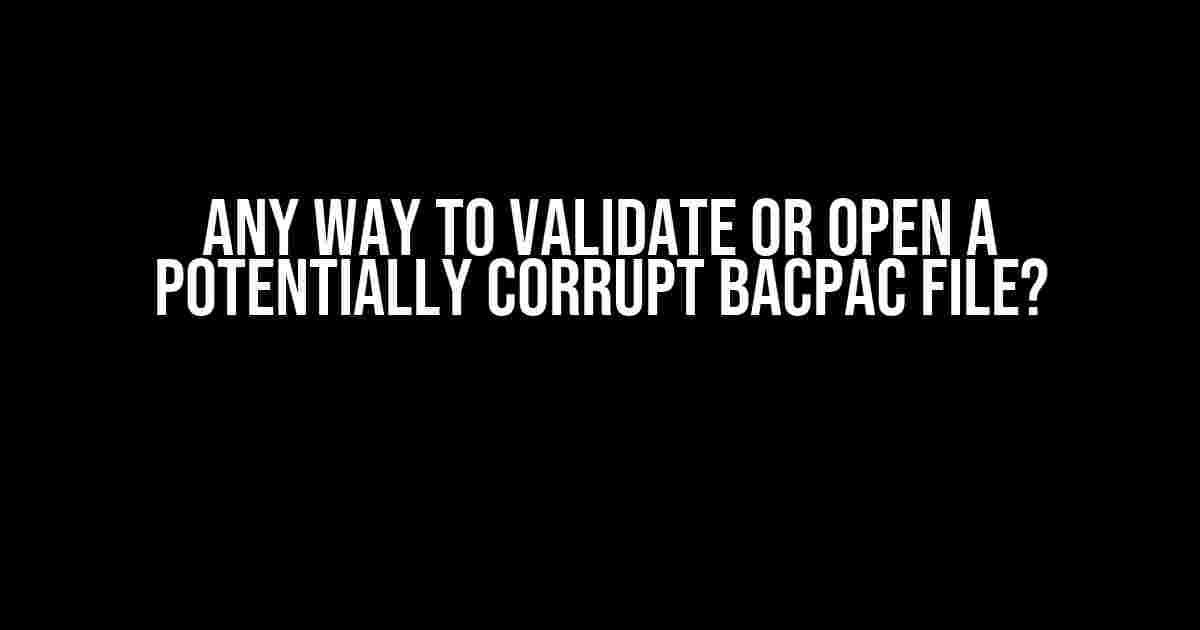A Bacpac file is a type of file used to store database schema and data in a single file. However, sometimes these files can become corrupted, making it difficult to open or validate them. If you’re facing this issue, don’t worry! We’ve got you covered.
Validate a Bacpac File
You can validate a Bacpac file using the sqlpackage command-line utility. Here’s an example command:
sqlpackage /Action:Verify /SourceFile:"path_to_your_bacpac_file.bacpac"This command will check the Bacpac file for any errors or inconsistencies and provide a report on its validity.
Open a Corrupt Bacpac File
If the Bacpac file is corrupted, you can try to open it using the sqlpackage command with the /Action:Import option. Here’s an example command:
sqlpackage /Action:Import /SourceFile:"path_to_your_bacpac_file.bacpac" /TargetDatabaseName:"your_database_name" /TargetServerName:"your_server_name"This command will attempt to import the Bacpac file into a new database. If the file is severely corrupted, you may need to try additional methods to recover the data.
Alternative Methods to Open a Corrupt Bacpac File
If the above method doesn’t work, you can try the following alternative methods:
-
Use a third-party Bacpac file repair tool, such as Bacpac Repair Tool or Apex Bacpac Repair.
-
Try to extract the database schema and data from the Bacpac file using a utility like 7-Zip or WinRAR.
-
Attempt to import individual objects from the Bacpac file using the
sqlpackagecommand with the/Action:Importoption and specifying the individual object to import.
Remember to always take backups of your Bacpac files regularly to prevent data loss in case of corruption.
Frequently Asked Question
Get the insider tips on opening a potentially corrupt bacpac file. Don’t let data loss get the best of you!
What are the common signs of a corrupt bacpac file?
Corrupt bacpac files often exhibit telling signs, such as incomplete or missing data, inconsistent database schema, or errors during the import process. You might also encounter issues with data types, truncated data, or encoding problems. If you’re experiencing any of these symptoms, it’s likely your bacpac file has gone rogue!
Can I use SQL Server Management Studio (SSMS) to validate and fix a corrupt bacpac file?
Yes, you can! SSMS offers a built-in feature to import and validate bacpac files. Simply create a new database, right-click on it, and select “Tasks” > “Import Data-tier Application”. Follow the wizard, and SSMS will attempt to import the bacpac file. If it’s corrupt, the process will fail, and you’ll receive an error message indicating the issue. You can then use the error details to troubleshoot and fix the problem.
How can I use the DacFx API to validate and open a corrupt bacpac file?
The DacFx API is a powerful tool for working with bacpac files. You can use it to validate and import the file programmatically. Create a new project in Visual Studio, add the DacFx NuGet package, and write code to load the bacpac file using the `DacPackage` class. You can then use the `Validate()` method to check the file’s integrity. If it’s corrupt, the method will throw an exception with details about the error.
Are there any third-party tools that can help me validate and repair a corrupt bacpac file?
Yes, there are several third-party tools available that can help you validate and repair corrupt bacpac files. Some popular options include Apex Data Loader, SQL Server Data Tools, and dbForge Studio. These tools offer advanced features, such as data validation, error detection, and repair capabilities. Be cautious, though, and always make sure to use reputable tools to avoid further data corruption!
What are some best practices to avoid corrupting bacpac files in the first place?
To avoid corrupting bacpac files, follow these best practices: use the latest version of SQL Server Management Studio (SSMS) or DacFx API to create and export the file, ensure consistent database schema, avoid interrupting the export process, and always validate the file after creation. Additionally, keep your database and system up-to-date, and use robust error handling mechanisms to catch potential issues during the export process.
